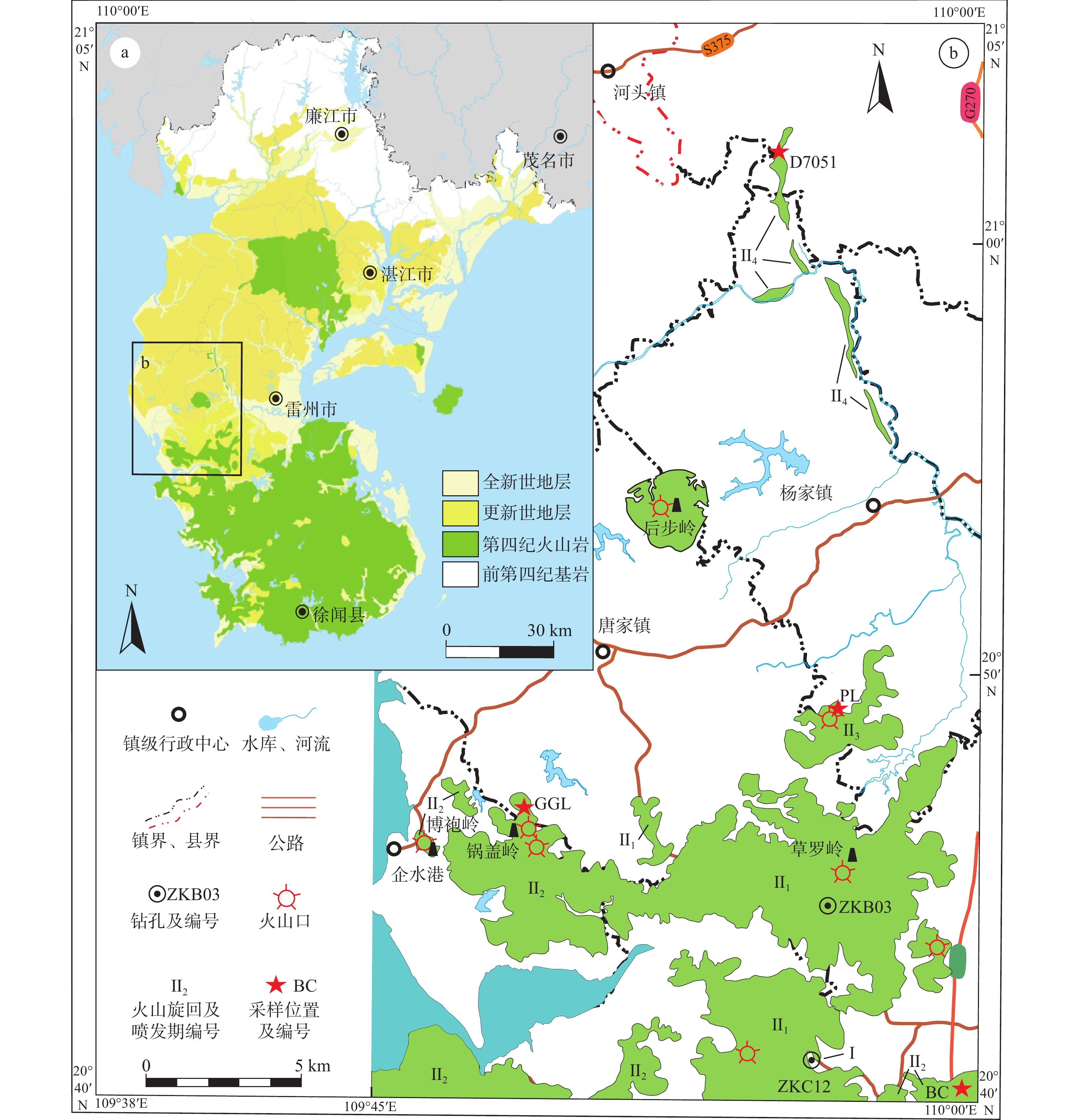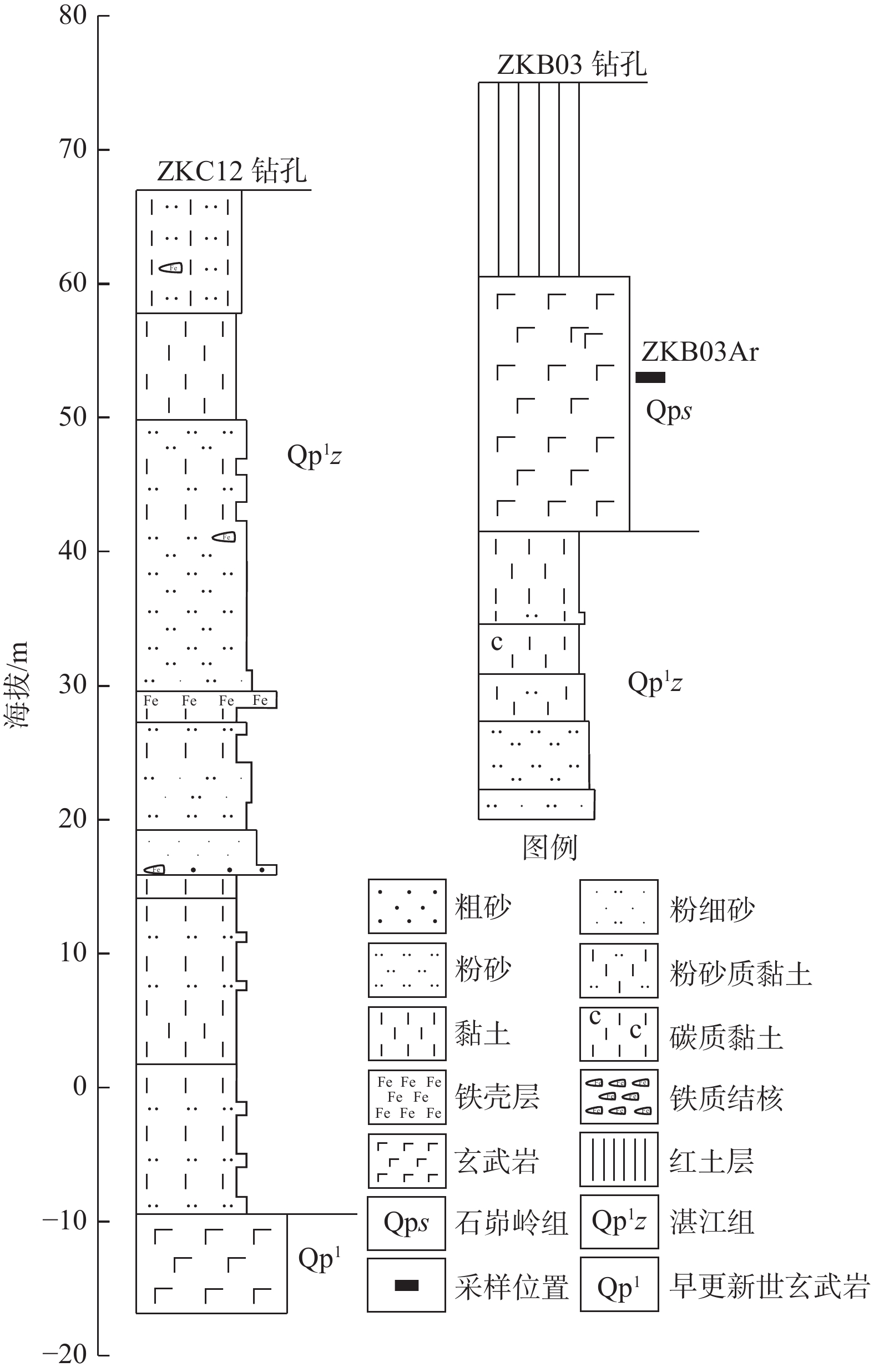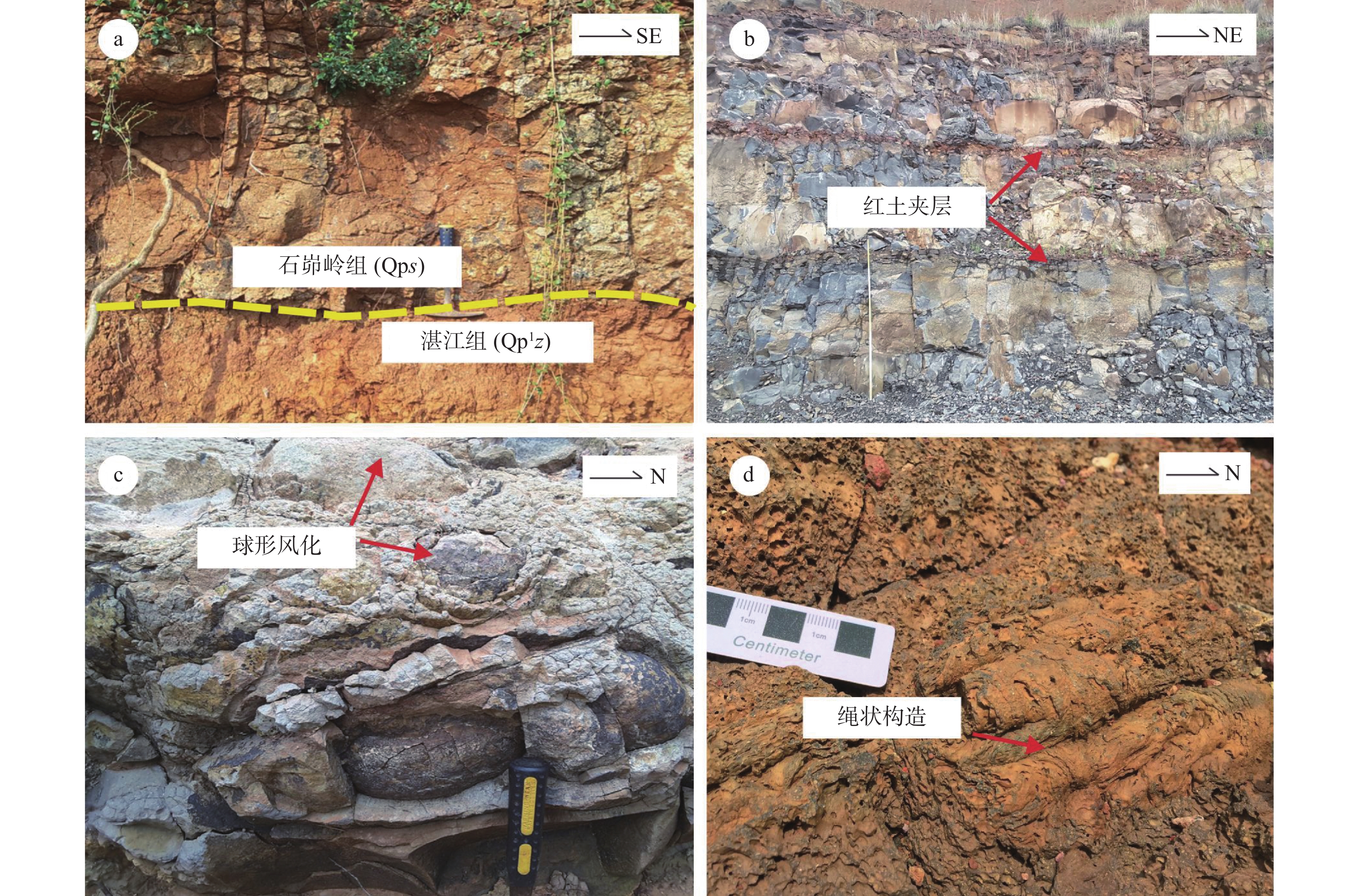40Ar/39Ar ages of Quaternary volcanic rocks from the midwest of the Leizhou Peninsula, and their geologic significance
-
摘要:
雷州半岛地区第四纪火山岩广泛分布,但对火山岩形成的时代还存在争议。文章利用高精度的激光阶段加热40Ar/39Ar法对雷州半岛中西部火山岩的年龄进行了测定,并结合与相邻地层的接触关系,划分了2个火山活动旋回。第Ⅰ旋回火山岩呈夹层产于湛江组内部,仅见于钻孔ZKC12中,岩性为橄榄拉斑玄武岩;第Ⅱ旋回火山岩在区内分布最广,覆盖在湛江组之上,40Ar/39Ar年龄为2.02~0.88 Ma,时代为早更新世早期至早更新世晚期,结合与周围地层的接触关系,进一步划分为4个喷发期。第1喷发期(Ⅱ1)规模最大,出露面积最广,形成2个喷发中心,40Ar/39Ar年龄为2.02±0.03 Ma;第2喷发期(Ⅱ2)主要分布于锅盖岭和北插一带,40Ar/39Ar年龄分别为1.77±0.03 Ma、1.70±0.03 Ma;第3喷发期(Ⅱ3)喷发中心位于火炬农场,40Ar/39Ar年龄为1.51±0.07 Ma;第4喷发期(Ⅱ4)岩性以沿裂隙喷发形成的溢流相的玄武质熔岩为主, 40Ar/39Ar年龄为0.88±0.14 Ma。火山活动明显受北东向和北西向基底断裂的控制。研究成果为雷州半岛地区火山活动时代、期次和活动规律研究提供了重要年龄证据。
Abstract:Quaternary volcanic rocks are widely distributed in the Leizhou Peninsula, but the age of volcanic formation remains controversial. This study used the high-precision laser stepwise heating 40Ar/39Ar method to date the age of volcanic samples from the midwest of the Leizhou Peninsula, and two volcanic cycles were determined by combining the contact relationship with the neighboring strata. Volcanic rocks of the first cycle (Ⅰ) occur as interlayers in the Zhanjiang Formation, only seen in Borehole ZKC12, and the lithology is olivine tholeiite; volcanic rocks of the second cycle (Ⅱ) are the most widely distributed in the study area, unconformably overlaying on the Zhanjiang Formation, with 40Ar/39Ar ages ranging from 2.02 to 0.88 Ma, indicating that they were erupted from the early stage of the early Pleistocene to the end of the early Pleistocene. On the combination of contact relationship with surrounding strata, the second cycle can be further divided into four eruption stages. The first eruption stage (Ⅱ1) has the largest scale and the most extensive area, forming two eruption centers with 40Ar/39Ar age of 2.02±0.03 Ma. The second eruption stage (Ⅱ2) centers in the areas of Guokailing and Beicha with 40Ar/39Ar ages of 1.77±0.03 Ma and 1.70±0.03 Ma, respectively. The eruptional center of the third eruption stage (Ⅱ3) lies at Huoju Farm, and the age of 40Ar/39Ar is 1.51±0.07 Ma. The lithology of the fourth eruption stage (Ⅱ4) is dominated by basaltic lava of overflow phase formed by fissure eruption, and the 40Ar/39Ar age is 0.88±0.14 Ma. The volcanic activity is obviously controlled by NE-trending and NW-trending basement faults. These results provide reliable age data to constrain Leizhou Peninsula’s forming age, eruption periods, and the law of volcanic activity.
-
Key words:
- volcanic rocks /
- 40Ar/39Ar method /
- volcanic cycles /
- Quaternary /
- Leizhou Peninsula /
- geochronology
-

-
表 1 雷州半岛中西部火山活动旋回划分表
Table 1. Division of volcanic eruption cycles in the midwest of the Leizhou Peninsula
地质年代 旋回 喷发期 产出层位 累计厚度/m 出露面
积/km2主要岩性 火山岩相 同位素
年龄/Ma纪 世 第四纪 更新世 Ⅱ Ⅱ4 石峁岭组 >4 .0m 4.1 橄榄拉斑玄武岩 溢流相 0.88 Ⅱ3 >200.0 m 10.8 石英拉斑玄武岩 溢流相 1.51 Ⅱ2 >101.4 m 34.3 石英拉斑玄武岩、
火山碎屑岩溢流相爆发相 1.70~1.77 Ⅱ1 >33.5 m 126.1 石英拉斑玄武岩、
火山碎屑岩溢流相爆发相 2.02 Ⅰ 湛江组 >7.4 m 无出露 橄榄拉斑玄武岩 溢流相 -
[1] BAI X J, QIU H N, LIU W G, et al. , 2018. Automatic 40Ar/39Ar dating techniques using multicollector ARGUS VI Noble gas mass spectrometer with self-made peripheral apparatus[J]. Journal of Earth Science, 29(2): 408-415. doi: 10.1007/s12583-017-0948-9
[2] CHU G Q, LIU J Q, 2018. Maar lakes in China and their significance in paleoclimatic research[J]. Acta Petrologica Sinica, 34(1): 4-12. (in Chinese with English abstract)
[3] FAN Q C, SUN Q, LI N, et al. , 2004. Periods of volcanic activity and magma evolution of Holocene in North Hainan Island[J]. Acta Petrologica Sinica, 20(3): 533-544. (in Chinese with English abstract)
[4] FENG G R, 1992. Basic characteristics and relationship to tectonic environment of the Late Cenozoic basalts along the coast of South China Sea[J]. Sun Yatsen University Forum(1): 93-103. (in Chinese with English abstract)
[5] GE T M, CHEN W J, XU H, et al. , 1989. The geomagnetic polarity time scale of quaternary for Leiqiong region: The K-Ar dating and palaeomagnetic evidences from igneous rocks[J]. Chinese Journal of Geophysics, 32(5): 550-558. (in Chinese with English abstract)
[6] GE T M, FAN L M, XU X, et al. , 1994. Paleomagnetism of Beihai and Zhanjiang Formations in Lei-Qiong region[J]. Marine Geology & Quaternary Geology, 14(4): 61-70. (in Chinese with English abstract)
[7] Guangdong Geological Bureau, 1996. Stratigraphy (Lithostratic) of Guangdong province[M]. Beijing: China University of Geosciences Press. (in Chinese)
[8] HAN Z Y, ZHANG Z Y, LIU R H, 1987. Volcanic Geomorphy in north Hainan island[J]. Tropical Geography, 7(1): 43-53. (in Chinese with English abstract)
[9] HO K S, CHEN J C, JUANG W S, 2000. Geochronology and geochemistry of late Cenozoic basalts from the Leiqiong area, southern China[J]. Journal of Asian Earth Sciences, 18(3): 307-324. doi: 10.1016/S1367-9120(99)00059-0
[10] HUANG Y K, ZOU H P, 1989. The tectonics and evolution of the Lei-Qiong Cenozoic graben basin[J]. Acta Scifntiarum Naturalium Universitatis Sunyaatseni, 28(3): 1-11. (in Chinese with English abstract)
[11] HUANG Z G, CAI F X, HAN Z Y, et al. , 1993. Leiqiong Quaternary volcano[M]. Beijing: Science Press: 170-188. (in Chinese)
[12] HUANG Z G, CAI F X, 1994. A new approach to the Quaternary volcanicity in the Leiqiong area[J]. Tropical Geography, 14(1): 1-10. (in Chinese with English abstract)
[13] KONG Z H, 2004. Hydrogeological property and laws of water abundance of the volcanic rocks in Leizhou Peninsula[J]. Tropical Geography, 24(2): 136-139. (in Chinese with English abstract)
[14] KOPPERS A A P, 2002. ArArCALC—Software for 40Ar/39Ar age calculations[J]. Computers & Geosciences, 28(5): 605-619.
[15] LEI T C, ZHU X, JIANG H, et al. , 2020. Geochemical survey atlas of land quality in the Leizhou Peninsula[M]. Wuhan: China University of Geosciences Press: 1-160. (in Chinese)
[16] LI S Z, SUO Y H, ZHOU J, et al. , 2022. Tectonic evolution of the South China Ocean-Continent Connection Zone: transition and mechanism of the Tethyan to the Pacific tectonic domains[J]. Journal of Geomechanics, 28(5): 683-704,doi: 10.12090/j.issn.1006-6616.20222809. (in Chinese with English abstract)
[17] LI W R, JI J Q, SANG H Q, et al. , 2013. Laser 40Ar/39Ar isochron dating on Leizhou Quaternary volcanic rocks[J]. Acta Petrologica Sinica, 29(8): 2775-2788. (in Chinese with English abstract)
[18] LI X, ZHANG Z Y, ZHANG J Y, 2018. The jewel inlaying on the crater: the magical Maar lake[J]. Geology and Mineral Resources of South China, 34(2): 168-173. (in Chinese with English abstract)
[19] LI X, ZHANG Z Y, ZHANG J Y, et al. , 2019. New progress in 1: 50000 reginal survey in Leizhou Peninsular area, Western Guangdong Province[J]. Geology and Mineral Resources of South China, 35(3): 293-305. (in Chinese with English abstract)
[20] LIU J Q, NEGENDANK J F W, WANG W Y, et al. , 2000. The distribution and geological characteristics of maar lakes in China[J]. Quaternary Sciences, 20(1): 78-86. (in Chinese with English abstract)
[21] LUO S W, 1998. Volcanism in Southern Leizhou Peninsula and its tectonic setting[J]. Guangdong Geology, 13(3): 20-24. (in Chinese)
[22] MCDOUGALL I, 2014. K/Ar and 40Ar/39Ar Isotopic dating techniques as applied to young volcanic rocks, particularly those associated with hominin localities[J]. Treatise on Geochemistry (Second Edition), 14: 1-15.
[23] No. 1 Hydrological and Engineering Geology Team of Guangdong Geological and Mineral Bureau, 1995. 1: 50 000 regional geological survey report of Maichen, Xiaqiao, Pengbigang, and Xuwenxian map-sheets[R]. (in Chinese)
[24] OSORIO-OCAMPO S, MACÍAS J L, POLA A, et al. , 2018. The eruptive history of the Pátzcuaro Lake area in the Michoacán Guanajuato volcanic field, central México: field mapping, C-14 and 40Ar/39Ar geochronology[J]. Journal of Volcanology and Geothermal Research, 358: 307-328. doi: 10.1016/j.jvolgeores.2018.06.003
[25] QIU H N, BAI X J, LIU W G, et al. , 2015. Automatic 40Ar/39Ar dating technique using multicollector ArgusVI MS with home-made apparatus[J]. Geochimica, 44(5): 477-484. (in Chinese with English abstract)
[26] STOREY M, ROBERTS R G, SAIDIN M, 2012. Astronomically calibrated 40Ar/39Ar age for the Toba supereruption and global synchronization of late Quaternary records[J]. Proceedings of the National Academy of Sciences of the United States of America, 109(46): 18684-18688.
[27] SU M, ZHANG C, XIE X N, et al. , 2014. Controlling factors on the submarine canyon system: a case study of the Central Canyon System in the Qiongdongnan Basin, northern South China Sea[J]. Science China, Earth Sciences, 57(10): 2457-2468. doi: 10.1007/s11430-014-4878-4
[28] SU M, HSIUNG K H, ZHANG C M, et al. , 2015. The linkage between longitudinal sediment routing systems and basin types in the northern South China Sea in perspective of source-to-sink[J]. Journal of Asian Earth Sciences, 111: 1-13. doi: 10.1016/j.jseaes.2015.05.011
[29] SUN J S, 1991. Cenozoic volcanic activity in the northern South China Sea and Guangdong coastal area[J]. Marine Geology & Quaternary Geology, 11(3): 45-67, 125-130. (in Chinese with English abstract)
[30] TU K, FLOWER M F J, CARLSON R W, et al. , 1991. Sr, Nd, and Pb isotopic compositions of Hainan basalts (South China): implications for a subcontinental lithosphere Dupal source[J]. Geology, 19(6): 567-569. doi: 10.1130/0091-7613(1991)019<0567:SNAPIC>2.3.CO;2
[31] WANG M, LU H Y, 2019. Age, geochemical composition and their paleoclimatic implications of the basalt in Leizhou Peninsula, Southern China[J]. Quaternary Sciences, 39(5): 1071-1082. (in Chinese with English abstract)
[32] WANG T T , ZHENG J P, ZHAO H, 2020. Unexposed Archean components and complex evolution beneath the Cathaysia Block: Evidence from zircon xenocrysts in the Cenozoic basalts in Leizhou Peninsula, South China[J]. Journal of Asian Earth Sciences, 192: 104268. DOI:10.1016/j.jseaes.2020.104268.
[33] WANG X C, LI Z X, LI X H, et al. , 2012. Temperature, pressure, and composition of the mantle source region of late Cenozoic basalts in Hainan Island, SE Asia: a consequence of a young thermal mantle plume close to subduction zones?[J]. Journal of Petrology, 53(1): 177-233. doi: 10.1093/petrology/egr061
[34] WU K Y, LIU Y L, HU D S, et al. , 2021. Types and evolution of faults in the east area of the Wushi Sag, Beibuwan Basin[J]. Journal of Geomechanics, 27(1): 52-62,doi: 10.12090/j.issn.1006-6616.2021.27.01.006. (in Chinese with English abstract)
[35] XIE X N, REN J Y, WANG Z F, et al. , 2015. Difference of tectonic evolution of continental marginal basins of South China Sea and relationship with SCS spreading[J]. Earth Science Frontiers, 22(1): 77-87. (in Chinese with English abstract)
[36] XU L F, LIU T H, 1996. The zonal differentiation of soil environmental background values and critical contents in Guangdong[J]. Journal of South China Agriculture University, 17(4): 58-62. (in Chinese with English abstract)
[37] YANG L K, WANG F, FENG H L, et al. , 2014. 40Ar/39Ar geochronology of Holocene volcanic activity at Changbaishan Tianchi volcano, Northeast China[J]. Quaternary Geochronology, 21: 106-114. doi: 10.1016/j.quageo.2013.10.008
[38] ZHANG F, QIU H N, HE H Y, et al. , 2009. Brief introduction to ArArCALC-software for data reduction in 40Ar/39Ar geochronology[J]. Geochimica, 38(1): 53-56. (in Chinese with English abstract)
[39] ZHANG H N, ZHAO X T, 1984. Characteristics of the neotectonic movement in the Hainan Island and Leizhou Peninsula area[J]. Chinese Journal of Geology, 19(3): 276-287. (in Chinese with English abstract)
[40] ZHANG K X, HE W H, LUO M S, et al. , 2017. Sedimentary tectonic map of China (1: 2 500 000)[M]. Beijing: Geology Press: 1-604. (in Chinese)
[41] ZHAO Y D, GAN H J, CHEN S B, et al. , 2015. Determination of Zhu-Qiong movement: the enlightenment from tectonic and sedimentary characteristics of Fushan Sag, Beibuwan Basin[J]. Geology in China, 42(4): 948-959. (in Chinese with English abstract)
[42] ZHENG W Q, 1999. Demonstration and evolution of tectonic movements in the Leizhou Peninsula since the Quaternary period[J]. Guangdong Geology, 14(1): 9-16. (in Chinese with English abstract)
[43] ZHOU J, JI J Q, DEINO A, et al. , 2013. Laser fusion 40Ar/39Ar dating on young volcanic rocks[J]. Acta Petrologica Sinica, 29(8): 2811-2825. (in Chinese with English abstract)
[44] ZHU Z Y, XU Y F, WEN Q Z, et al. , 2001. The stratigraphy and chronology of multicycle quaternary volcanic rock-red soil sequence in Leizhou Peninsula, South China[J]. Quaternary Sciences, 21(3): 270-276. (in Chinese with English abstract)
[45] 储国强, 刘嘉麒, 2018. 中国玛珥湖及其研究意义[J]. 岩石学报, 34(1): 4-12.
[46] 樊祺诚, 孙谦, 李霓, 等, 2004. 琼北火山活动分期与全新世岩浆演化[J]. 岩石学报, 20(3): 533-544. doi: 10.3969/j.issn.1000-0569.2004.03.017
[47] 冯国荣, 1992. 华南沿海晚新生代玄武岩基本特征及其与构造环境的关系[J]. 中山大学学报论丛(1): 93-103.
[48] 葛同明, 陈文寄, 徐行, 等, 1989. 雷琼地区第四纪地磁极性年表: 火山岩钾-氩年龄及古地磁学证据[J]. 地球物理学报, 32(5): 550-558. doi: 10.3321/j.issn:0001-5733.1989.05.007
[49] 葛同明, 樊利民, 徐行, 等, 1994. 雷琼地区湛江组、北海组的古地磁学研究[J]. 海洋地质与第四纪地质, 14(4): 61-70.
[50] 广东省地质矿产局, 1996. 广东省岩石地层[M]. 武汉: 中国地质大学出版社.
[51] 广东省地质矿产局水文工程地质一大队, 1995. 1∶5万迈陈幅、下桥幅、蓬莳港幅、徐闻县幅区域地质调查报告[R].
[52] 韩中元, 张仲英, 刘瑞华, 1987. 海南岛北部火山地貌[J]. 热带地理, 7(1): 43-53.
[53] 黄玉昆, 邹和平, 1989. 雷琼新生代断陷盆地构造特征及其演化[J]. 中山大学学报(自然科学版), 28(3): 1-11.
[54] 黄镇国, 蔡福祥, 韩中元, 等, 1993. 雷琼第四纪火山[M]. 北京: 科学出版社: 170-188.
[55] 黄镇国, 蔡福祥, 1994. 雷琼第四纪火山活动的新认识[J]. 热带地理, 14(1): 1-10.
[56] 孔中恒, 2004. 雷州半岛火山岩的水文地质特征与富水规律[J]. 热带地理, 24(2): 136-139.
[57] 雷天赐, 朱鑫, 姜华, 等, 2020. 雷州半岛土地质量地球化学调查图集[M]. 武汉: 中国地质大学出版社: 1-160.
[58] 李三忠, 索艳慧, 周洁, 等, 2022. 华南洋陆过渡带构造演化: 特提斯构造域向太平洋构造域的转换过程与机制[J]. 地质力学学报, 28(5): 683-704,doi: 10.12090/j.issn.1006-6616.20222809.
[59] 李蔚然, 季建清, 桑海清, 等, 2013. 雷州半岛第四纪火山岩激光40Ar/39Ar等时线定年研究[J]. 岩石学报, 29(8): 2775-2788.
[60] 李响, 张宗言, 张楗钰, 2018. 镶嵌在火山口的“宝石”: 神奇的玛珥湖[J]. 华南地质与矿产, 34(2): 168-173.
[61] 李响, 张宗言, 张楗钰, 等, 2019. 粤西雷州半岛地区1∶5万区域地质调查成果与主要进展[J]. 华南地质与矿产, 35(3): 293-305.
[62] 刘嘉麒, NEGENDANK J F W, 王文远, 等, 2000. 中国玛珥湖的时空分布与地质特征[J]. 第四纪研究, 20(1): 78-86.
[63] 罗树文, 1998. 雷州半岛南部火山活动及其构造背景[J]. 广东地质, 13(3): 20-24.
[64] 邱华宁, 白秀娟, 刘文贵, 等, 2015. 自动化40Ar/39Ar定年设备研制[J]. 地球化学, 44(5): 477-484. doi: 10.3969/j.issn.0379-1726.2015.05.007
[65] 孙嘉诗, 1991. 南海北部及广东沿海新生代火山活动[J]. 海洋地质与第四纪地质, 11(3): 45-67, 125-130.
[66] 汪苗, 鹿化煜, 2019. 雷州半岛玛珥湖区玄武岩的年代、地球化学特征及其意义[J]. 第四纪研究, 39(5): 1071-1082. doi: 10.11928/j.issn.1001-7410.2019.05.01
[67] 吴孔友, 刘煜磊, 胡德胜, 等, 2021. 北部湾盆地乌石凹陷东区断裂类型及其形成演化[J]. 地质力学学报, 27(1): 52-62,doi: 10.12090/j.issn.1006-6616.2021.27.01.006.
[68] 解习农, 任建业, 王振峰, 等, 2015. 南海大陆边缘盆地构造演化差异性及其与南海扩张耦合关系[J]. 地学前缘, 22(1): 77-87.
[69] 许炼烽, 刘腾辉, 1996. 广东土壤环境背景值和临界含量的地带性分异[J]. 华南农业大学学报, 17(4): 58-62.
[70] 张凡, 邱华宁, 贺怀宇, 等, 2009. 40Ar/39Ar年代学数据处理软件ArArCALC简介[J]. 地球化学, 38(1): 53-56.
[71] 张虎男, 赵希涛, 1984. 雷琼地区新构造运动的特征[J]. 地质科学, 19(3): 276-287.
[72] 张克信, 何卫红, 骆满生, 等, 2017. 中国沉积岩建造与沉积大地构造演化[M]. 北京: 地质出版社: 1-604.
[73] 赵迎冬, 甘华军, 陈善斌, 等, 2015. 珠琼运动的厘定: 来自北部湾盆地福山凹陷构造沉积特征的启示[J]. 中国地质, 42(4): 948-959.
[74] 郑王琼, 1999. 第四纪以来雷州半岛构造运动的表现及演化[J]. 广东地质, 14(1): 9-16.
[75] 周晶, 季建清, DEINO A, 等, 2013. (极)年轻火山岩激光熔蚀40Ar/39Ar定年[J]. 岩石学报, 29(8): 2811-2825.
[76] 朱照宇, 徐义芳, 文启忠, 等, 2001. 华南雷州半岛第四纪多旋回火山岩-红土系列的层序与年代[J]. 第四纪研究, 21(3): 270-276.
-




 下载:
下载:


